service indicator DODGE DURANGO 2005 2.G Owners Manual
[x] Cancel search | Manufacturer: DODGE, Model Year: 2005, Model line: DURANGO, Model: DODGE DURANGO 2005 2.GPages: 416, PDF Size: 14.25 MB
Page 46 of 416
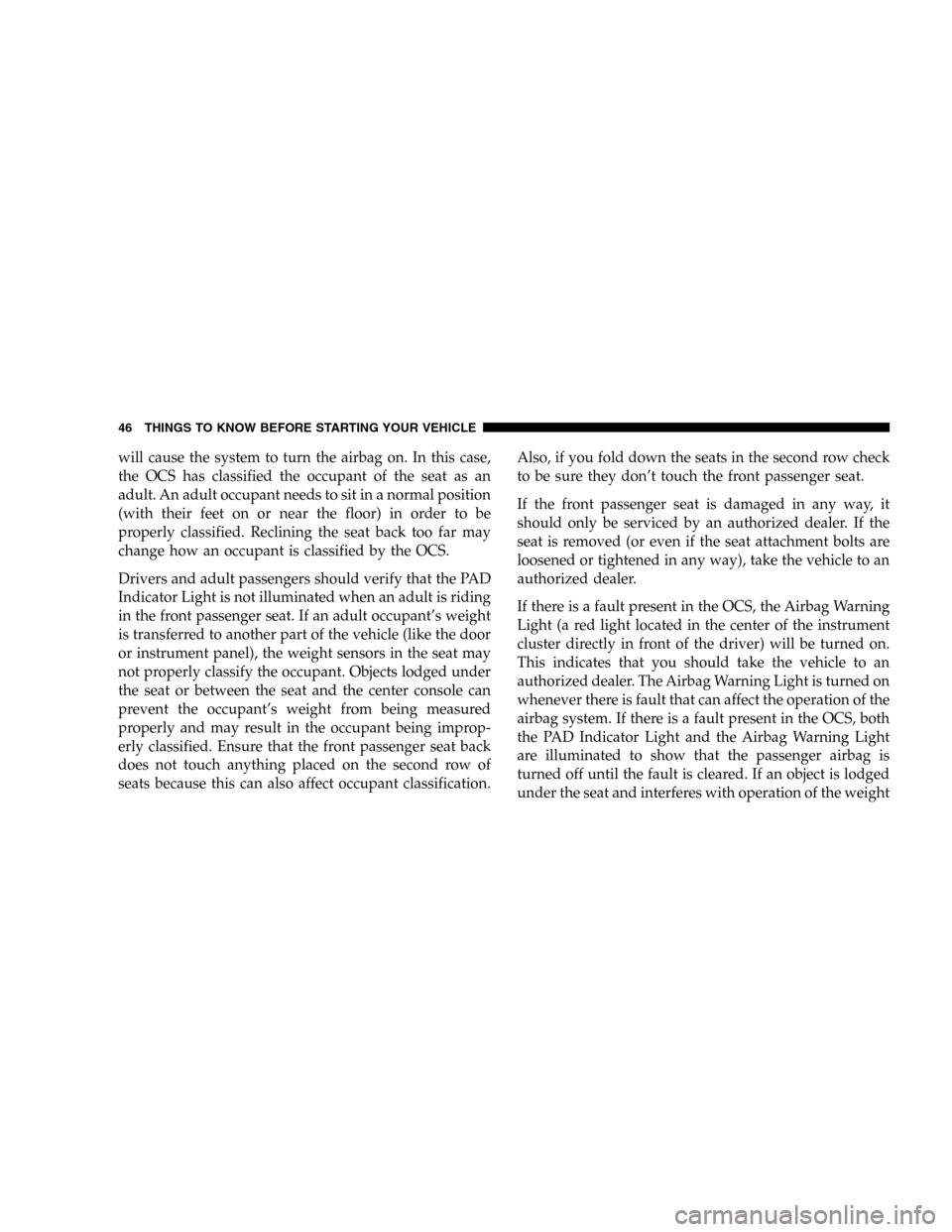
will cause the system to turn the airbag on. In this case,
the OCS has classified the occupant of the seat as an
adult. An adult occupant needs to sit in a normal position
(with their feet on or near the floor) in order to be
properly classified. Reclining the seat back too far may
change how an occupant is classified by the OCS.
Drivers and adult passengers should verify that the PAD
Indicator Light is not illuminated when an adult is riding
in the front passenger seat. If an adult occupant’s weight
is transferred to another part of the vehicle (like the door
or instrument panel), the weight sensors in the seat may
not properly classify the occupant. Objects lodged under
the seat or between the seat and the center console can
prevent the occupant’s weight from being measured
properly and may result in the occupant being improp-
erly classified. Ensure that the front passenger seat back
does not touch anything placed on the second row of
seats because this can also affect occupant classification.Also, if you fold down the seats in the second row check
to be sure they don’t touch the front passenger seat.
If the front passenger seat is damaged in any way, it
should only be serviced by an authorized dealer. If the
seat is removed (or even if the seat attachment bolts are
loosened or tightened in any way), take the vehicle to an
authorized dealer.
If there is a fault present in the OCS, the Airbag Warning
Light (a red light located in the center of the instrument
cluster directly in front of the driver) will be turned on.
This indicates that you should take the vehicle to an
authorized dealer. The Airbag Warning Light is turned on
whenever there is fault that can affect the operation of the
airbag system. If there is a fault present in the OCS, both
the PAD Indicator Light and the Airbag Warning Light
are illuminated to show that the passenger airbag is
turned off until the fault is cleared. If an object is lodged
under the seat and interferes with operation of the weight
46 THINGS TO KNOW BEFORE STARTING YOUR VEHICLE
Page 106 of 416
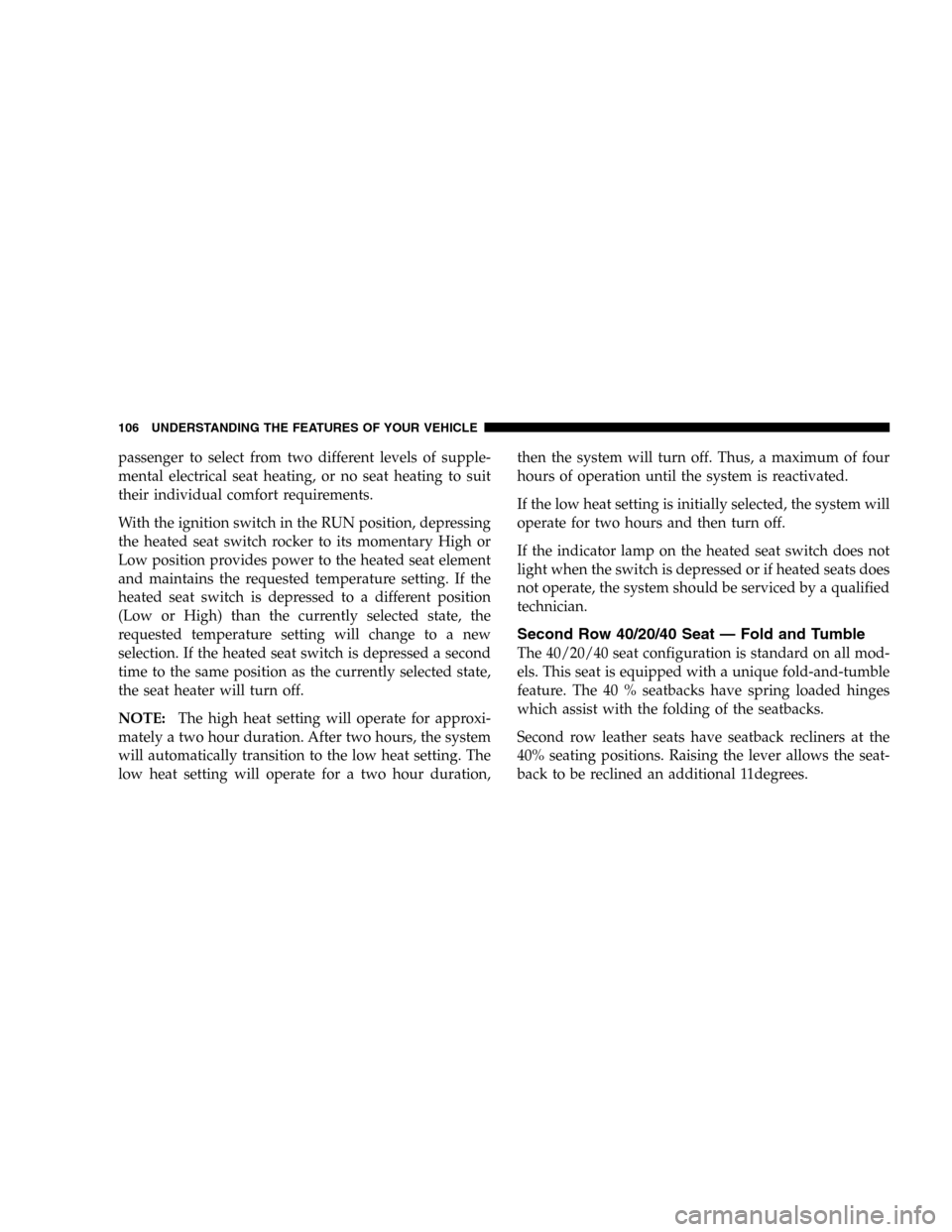
passenger to select from two different levels of supple-
mental electrical seat heating, or no seat heating to suit
their individual comfort requirements.
With the ignition switch in the RUN position, depressing
the heated seat switch rocker to its momentary High or
Low position provides power to the heated seat element
and maintains the requested temperature setting. If the
heated seat switch is depressed to a different position
(Low or High) than the currently selected state, the
requested temperature setting will change to a new
selection. If the heated seat switch is depressed a second
time to the same position as the currently selected state,
the seat heater will turn off.
NOTE:The high heat setting will operate for approxi-
mately a two hour duration. After two hours, the system
will automatically transition to the low heat setting. The
low heat setting will operate for a two hour duration,then the system will turn off. Thus, a maximum of four
hours of operation until the system is reactivated.
If the low heat setting is initially selected, the system will
operate for two hours and then turn off.
If the indicator lamp on the heated seat switch does not
light when the switch is depressed or if heated seats does
not operate, the system should be serviced by a qualified
technician.
Second Row 40/20/40 Seat — Fold and Tumble
The 40/20/40 seat configuration is standard on all mod-
els. This seat is equipped with a unique fold-and-tumble
feature. The 40 % seatbacks have spring loaded hinges
which assist with the folding of the seatbacks.
Second row leather seats have seatback recliners at the
40% seating positions. Raising the lever allows the seat-
back to be reclined an additional 11degrees.
106 UNDERSTANDING THE FEATURES OF YOUR VEHICLE
Page 164 of 416
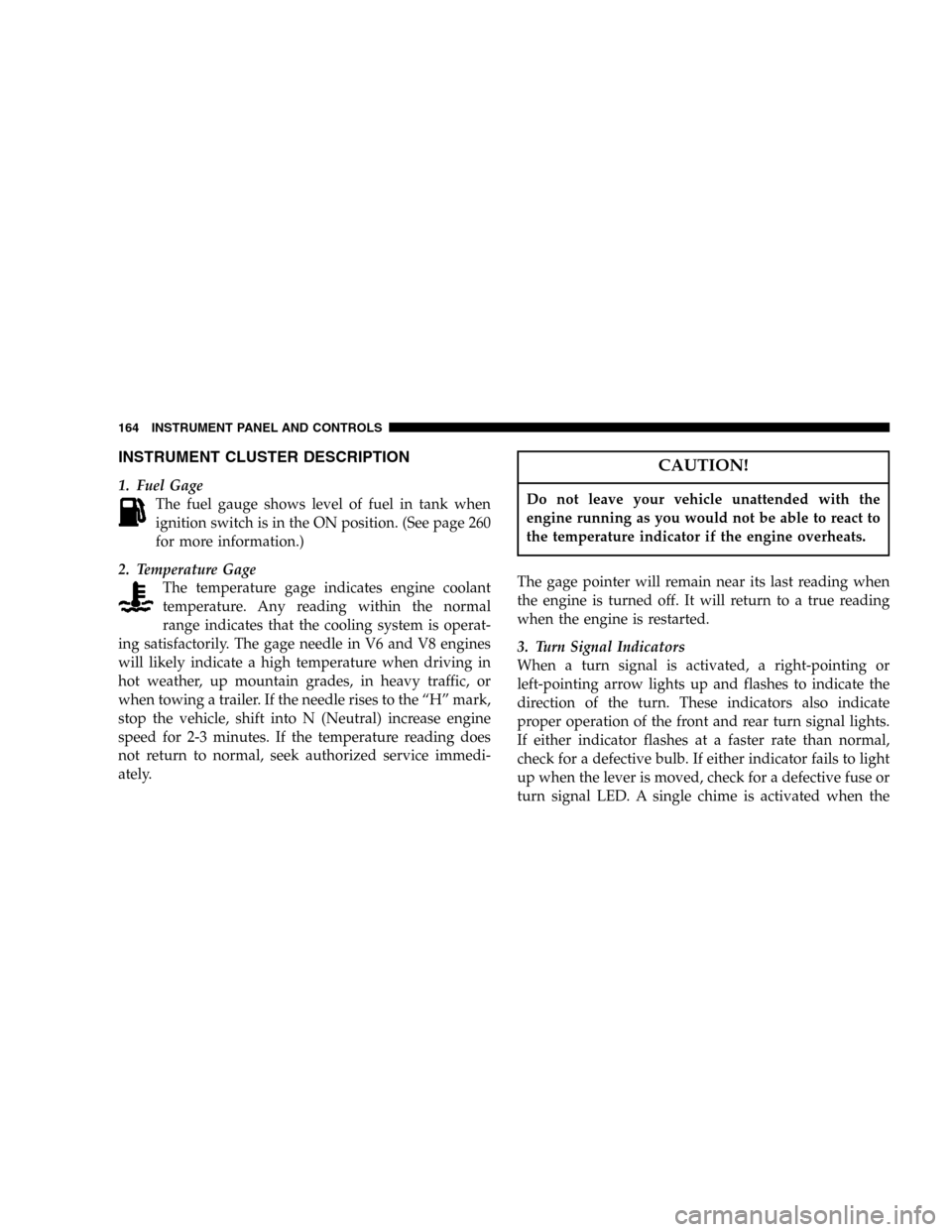
INSTRUMENT CLUSTER DESCRIPTION
1. Fuel Gage
The fuel gauge shows level of fuel in tank when
ignition switch is in the ON position. (See page 260
for more information.)
2. Temperature Gage
The temperature gage indicates engine coolant
temperature. Any reading within the normal
range indicates that the cooling system is operat-
ing satisfactorily. The gage needle in V6 and V8 engines
will likely indicate a high temperature when driving in
hot weather, up mountain grades, in heavy traffic, or
when towing a trailer. If the needle rises to the “H” mark,
stop the vehicle, shift into N (Neutral) increase engine
speed for 2-3 minutes. If the temperature reading does
not return to normal, seek authorized service immedi-
ately.
CAUTION!
Do not leave your vehicle unattended with the
engine running as you would not be able to react to
the temperature indicator if the engine overheats.
The gage pointer will remain near its last reading when
the engine is turned off. It will return to a true reading
when the engine is restarted.
3. Turn Signal Indicators
When a turn signal is activated, a right-pointing or
left-pointing arrow lights up and flashes to indicate the
direction of the turn. These indicators also indicate
proper operation of the front and rear turn signal lights.
If either indicator flashes at a faster rate than normal,
check for a defective bulb. If either indicator fails to light
up when the lever is moved, check for a defective fuse or
turn signal LED. A single chime is activated when the
164 INSTRUMENT PANEL AND CONTROLS
Page 165 of 416
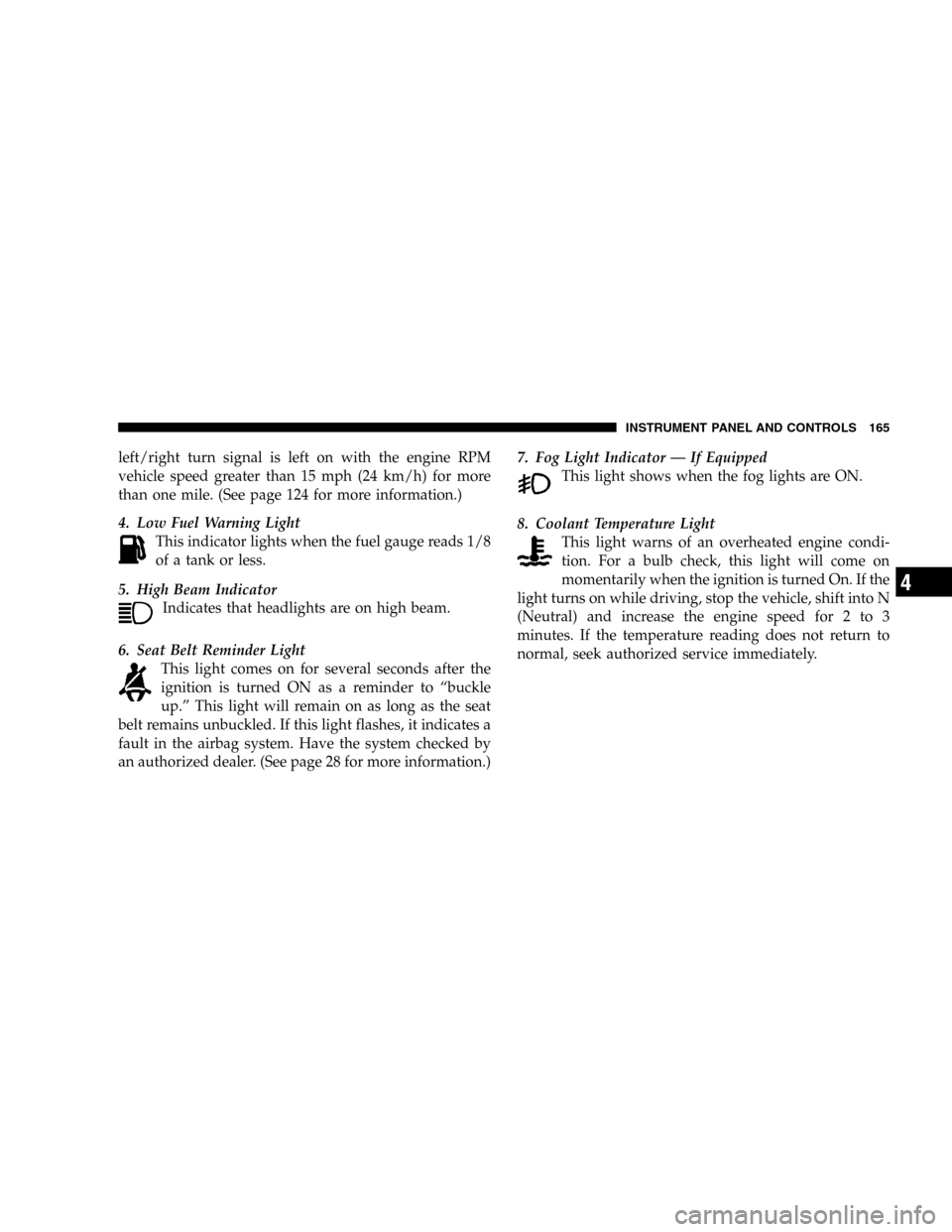
left/right turn signal is left on with the engine RPM
vehicle speed greater than 15 mph (24 km/h) for more
than one mile. (See page 124 for more information.)
4. Low Fuel Warning Light
This indicator lights when the fuel gauge reads 1/8
of a tank or less.
5. High Beam Indicator
Indicates that headlights are on high beam.
6. Seat Belt Reminder Light
This light comes on for several seconds after the
ignition is turned ON as a reminder to “buckle
up.” This light will remain on as long as the seat
belt remains unbuckled. If this light flashes, it indicates a
fault in the airbag system. Have the system checked by
an authorized dealer. (See page 28 for more information.)7. Fog Light Indicator — If Equipped
This light shows when the fog lights are ON.
8. Coolant Temperature Light
This light warns of an overheated engine condi-
tion. For a bulb check, this light will come on
momentarily when the ignition is turned On. If the
light turns on while driving, stop the vehicle, shift into N
(Neutral) and increase the engine speed for 2 to 3
minutes. If the temperature reading does not return to
normal, seek authorized service immediately.
INSTRUMENT PANEL AND CONTROLS 165
4
Page 167 of 416
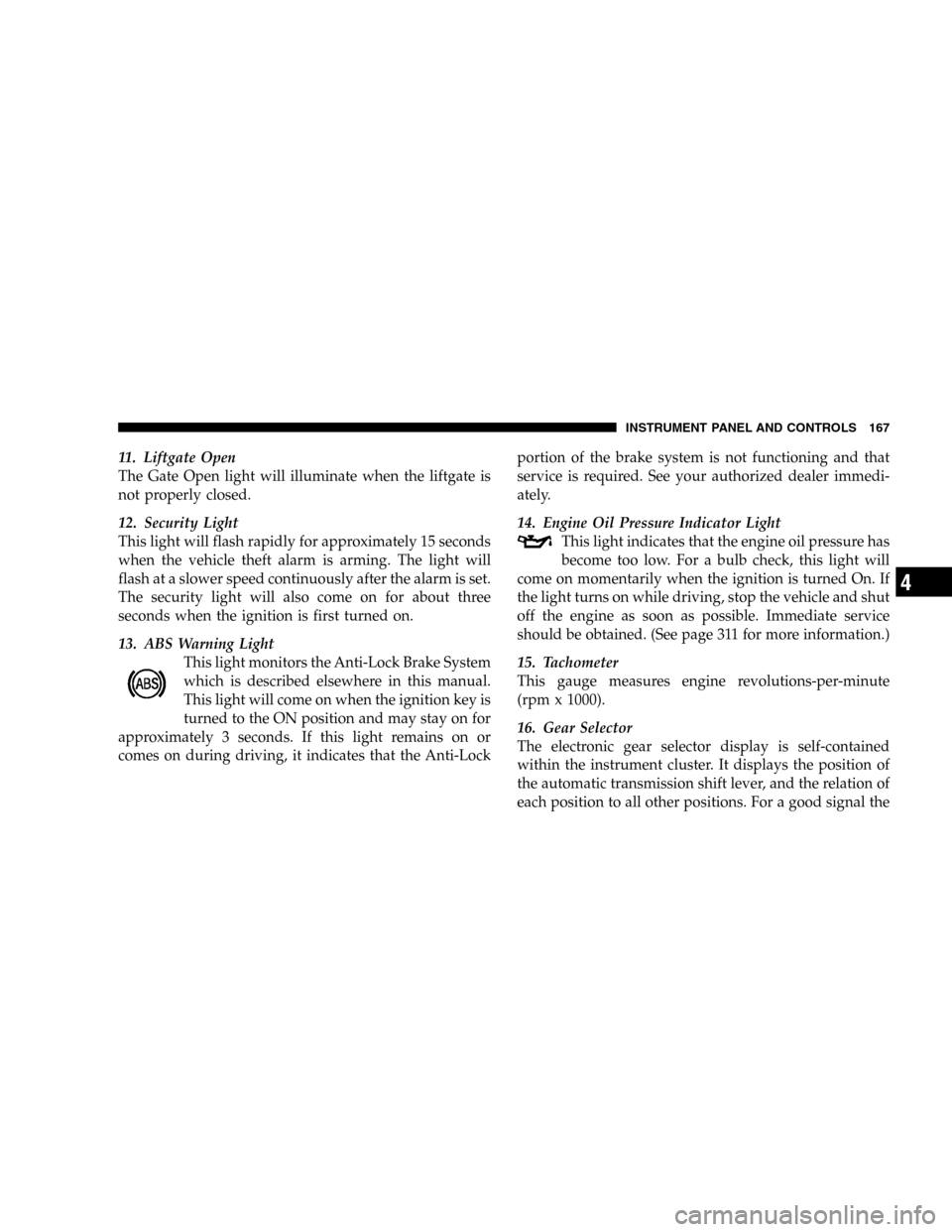
11. Liftgate Open
The Gate Open light will illuminate when the liftgate is
not properly closed.
12. Security Light
This light will flash rapidly for approximately 15 seconds
when the vehicle theft alarm is arming. The light will
flash at a slower speed continuously after the alarm is set.
The security light will also come on for about three
seconds when the ignition is first turned on.
13. ABS Warning Light
This light monitors the Anti-Lock Brake System
which is described elsewhere in this manual.
This light will come on when the ignition key is
turned to the ON position and may stay on for
approximately 3 seconds. If this light remains on or
comes on during driving, it indicates that the Anti-Lockportion of the brake system is not functioning and that
service is required. See your authorized dealer immedi-
ately.
14. Engine Oil Pressure Indicator Light
This light indicates that the engine oil pressure has
become too low. For a bulb check, this light will
come on momentarily when the ignition is turned On. If
the light turns on while driving, stop the vehicle and shut
off the engine as soon as possible. Immediate service
should be obtained. (See page 311 for more information.)
15. Tachometer
This gauge measures engine revolutions-per-minute
(rpm x 1000).
16. Gear Selector
The electronic gear selector display is self-contained
within the instrument cluster. It displays the position of
the automatic transmission shift lever, and the relation of
each position to all other positions. For a good signal the
INSTRUMENT PANEL AND CONTROLS 167
4
Page 168 of 416
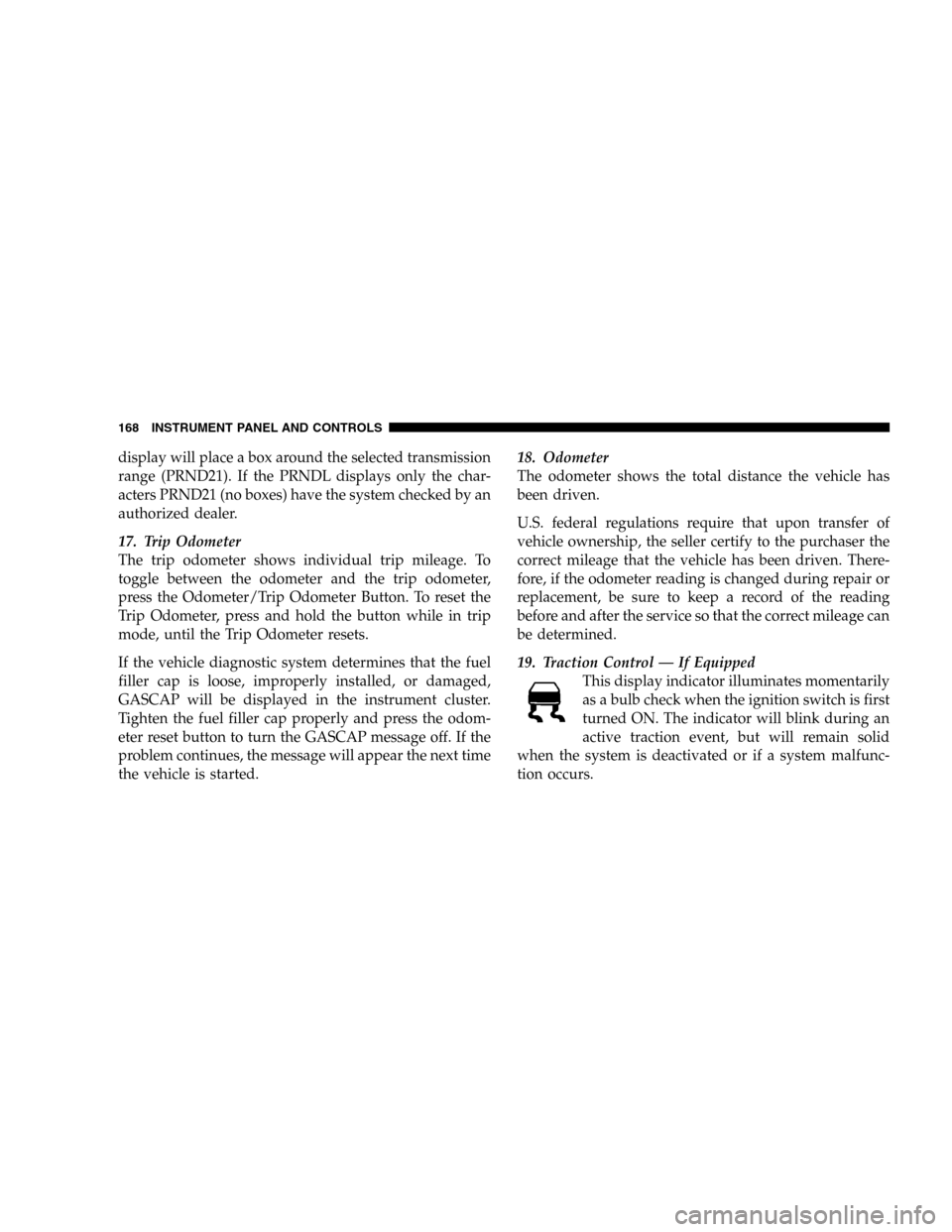
display will place a box around the selected transmission
range (PRND21). If the PRNDL displays only the char-
acters PRND21 (no boxes) have the system checked by an
authorized dealer.
17. Trip Odometer
The trip odometer shows individual trip mileage. To
toggle between the odometer and the trip odometer,
press the Odometer/Trip Odometer Button. To reset the
Trip Odometer, press and hold the button while in trip
mode, until the Trip Odometer resets.
If the vehicle diagnostic system determines that the fuel
filler cap is loose, improperly installed, or damaged,
GASCAP will be displayed in the instrument cluster.
Tighten the fuel filler cap properly and press the odom-
eter reset button to turn the GASCAP message off. If the
problem continues, the message will appear the next time
the vehicle is started.18. Odometer
The odometer shows the total distance the vehicle has
been driven.
U.S. federal regulations require that upon transfer of
vehicle ownership, the seller certify to the purchaser the
correct mileage that the vehicle has been driven. There-
fore, if the odometer reading is changed during repair or
replacement, be sure to keep a record of the reading
before and after the service so that the correct mileage can
be determined.
19. Traction Control — If Equipped
This display indicator illuminates momentarily
as a bulb check when the ignition switch is first
turned ON. The indicator will blink during an
active traction event, but will remain solid
when the system is deactivated or if a system malfunc-
tion occurs.
168 INSTRUMENT PANEL AND CONTROLS
Page 169 of 416
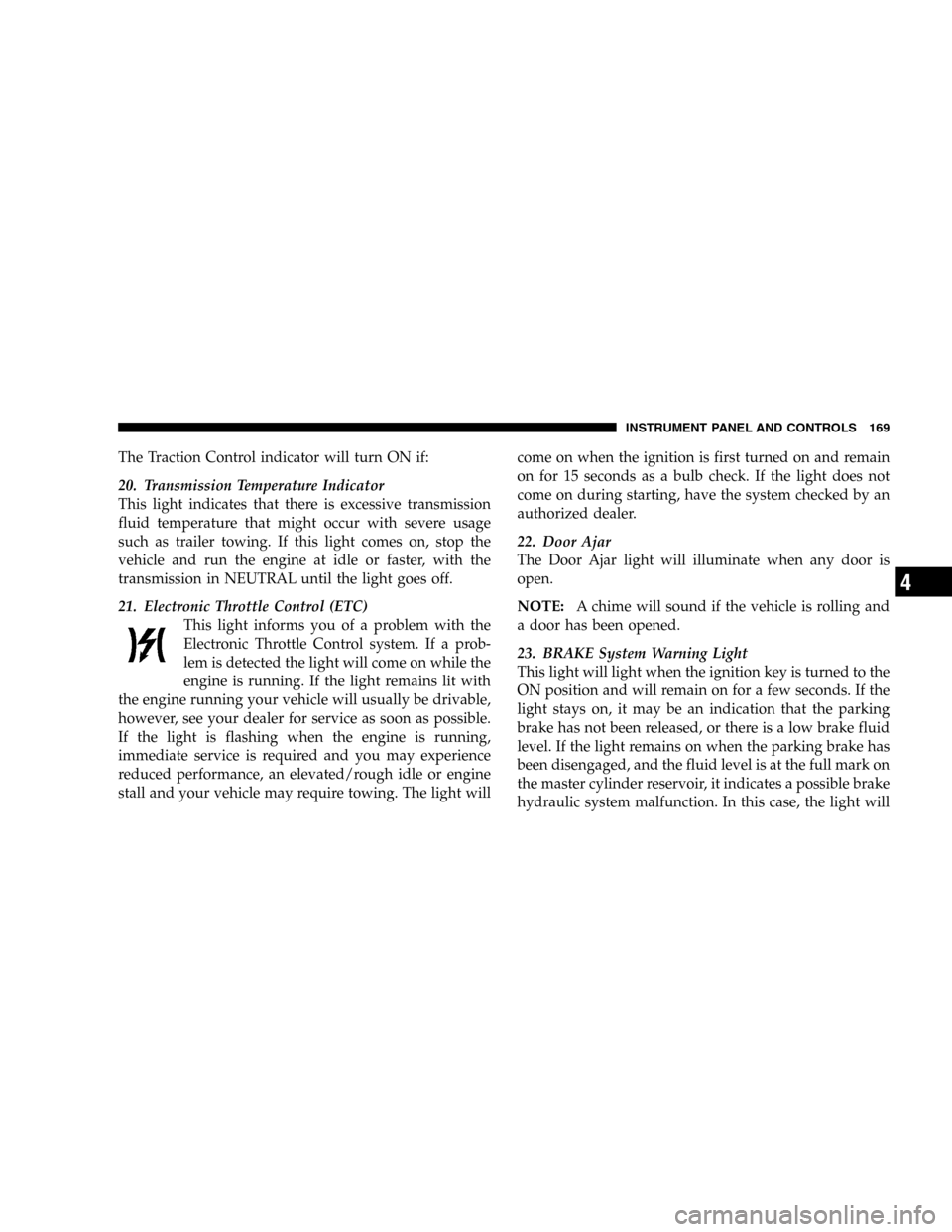
The Traction Control indicator will turn ON if:
20. Transmission Temperature Indicator
This light indicates that there is excessive transmission
fluid temperature that might occur with severe usage
such as trailer towing. If this light comes on, stop the
vehicle and run the engine at idle or faster, with the
transmission in NEUTRAL until the light goes off.
21. Electronic Throttle Control (ETC)
This light informs you of a problem with the
Electronic Throttle Control system. If a prob-
lem is detected the light will come on while the
engine is running. If the light remains lit with
the engine running your vehicle will usually be drivable,
however, see your dealer for service as soon as possible.
If the light is flashing when the engine is running,
immediate service is required and you may experience
reduced performance, an elevated/rough idle or engine
stall and your vehicle may require towing. The light willcome on when the ignition is first turned on and remain
on for 15 seconds as a bulb check. If the light does not
come on during starting, have the system checked by an
authorized dealer.
22. Door Ajar
The Door Ajar light will illuminate when any door is
open.
NOTE:A chime will sound if the vehicle is rolling and
a door has been opened.
23. BRAKE System Warning Light
This light will light when the ignition key is turned to the
ON position and will remain on for a few seconds. If the
light stays on, it may be an indication that the parking
brake has not been released, or there is a low brake fluid
level. If the light remains on when the parking brake has
been disengaged, and the fluid level is at the full mark on
the master cylinder reservoir, it indicates a possible brake
hydraulic system malfunction. In this case, the light will
INSTRUMENT PANEL AND CONTROLS 169
4
Page 170 of 416
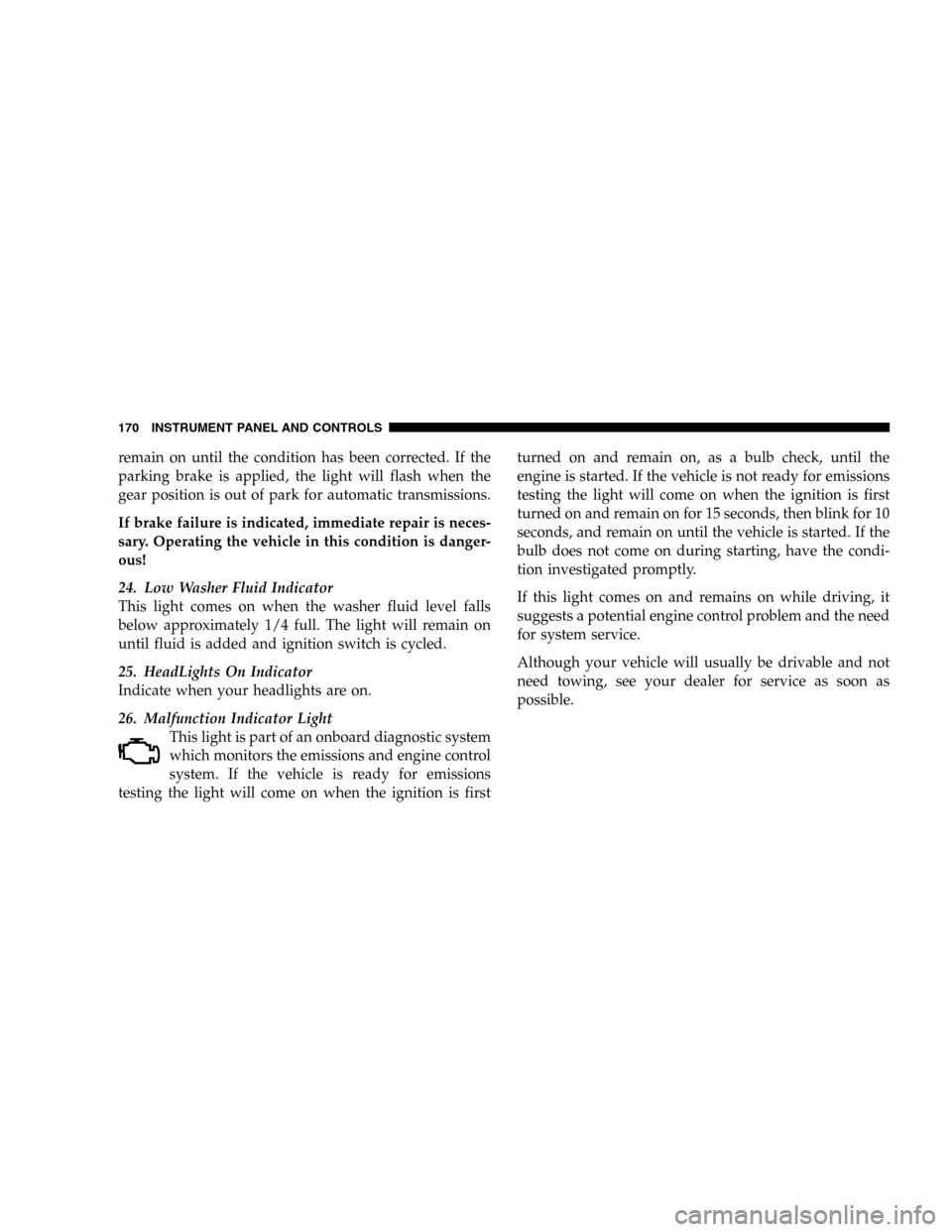
remain on until the condition has been corrected. If the
parking brake is applied, the light will flash when the
gear position is out of park for automatic transmissions.
If brake failure is indicated, immediate repair is neces-
sary. Operating the vehicle in this condition is danger-
ous!
24. Low Washer Fluid Indicator
This light comes on when the washer fluid level falls
below approximately 1/4 full. The light will remain on
until fluid is added and ignition switch is cycled.
25. HeadLights On Indicator
Indicate when your headlights are on.
26. Malfunction Indicator Light
This light is part of an onboard diagnostic system
which monitors the emissions and engine control
system. If the vehicle is ready for emissions
testing the light will come on when the ignition is firstturned on and remain on, as a bulb check, until the
engine is started. If the vehicle is not ready for emissions
testing the light will come on when the ignition is first
turned on and remain on for 15 seconds, then blink for 10
seconds, and remain on until the vehicle is started. If the
bulb does not come on during starting, have the condi-
tion investigated promptly.
If this light comes on and remains on while driving, it
suggests a potential engine control problem and the need
for system service.
Although your vehicle will usually be drivable and not
need towing, see your dealer for service as soon as
possible.
170 INSTRUMENT PANEL AND CONTROLS
Page 171 of 416
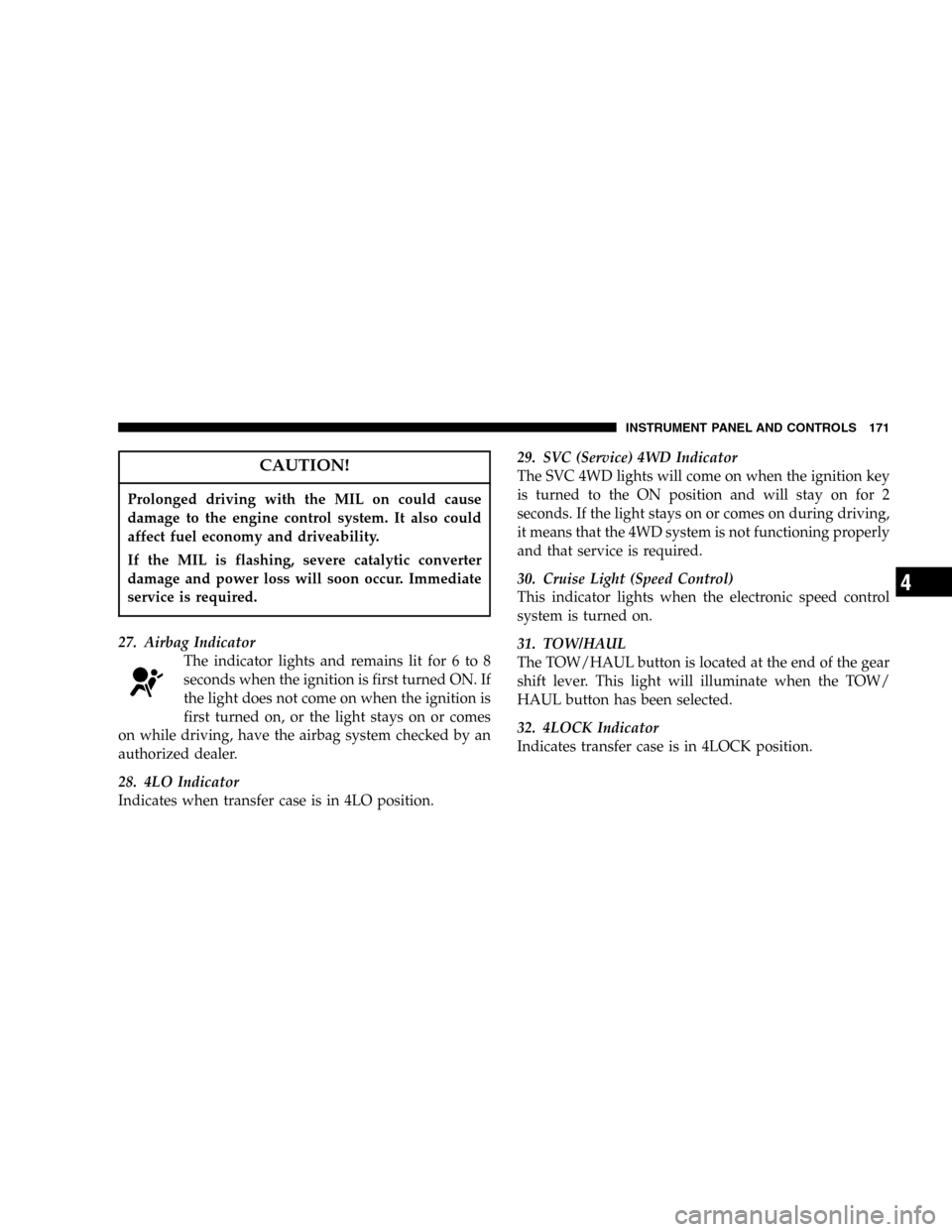
CAUTION!
Prolonged driving with the MIL on could cause
damage to the engine control system. It also could
affect fuel economy and driveability.
If the MIL is flashing, severe catalytic converter
damage and power loss will soon occur. Immediate
service is required.
27. Airbag Indicator
The indicator lights and remains lit for 6 to 8
seconds when the ignition is first turned ON. If
the light does not come on when the ignition is
first turned on, or the light stays on or comes
on while driving, have the airbag system checked by an
authorized dealer.
28. 4LO Indicator
Indicates when transfer case is in 4LO position.29. SVC (Service) 4WD Indicator
The SVC 4WD lights will come on when the ignition key
is turned to the ON position and will stay on for 2
seconds. If the light stays on or comes on during driving,
it means that the 4WD system is not functioning properly
and that service is required.
30. Cruise Light (Speed Control)
This indicator lights when the electronic speed control
system is turned on.
31. TOW/HAUL
The TOW/HAUL button is located at the end of the gear
shift lever. This light will illuminate when the TOW/
HAUL button has been selected.
32. 4LOCK Indicator
Indicates transfer case is in 4LOCK position.
INSTRUMENT PANEL AND CONTROLS 171
4
Page 230 of 416
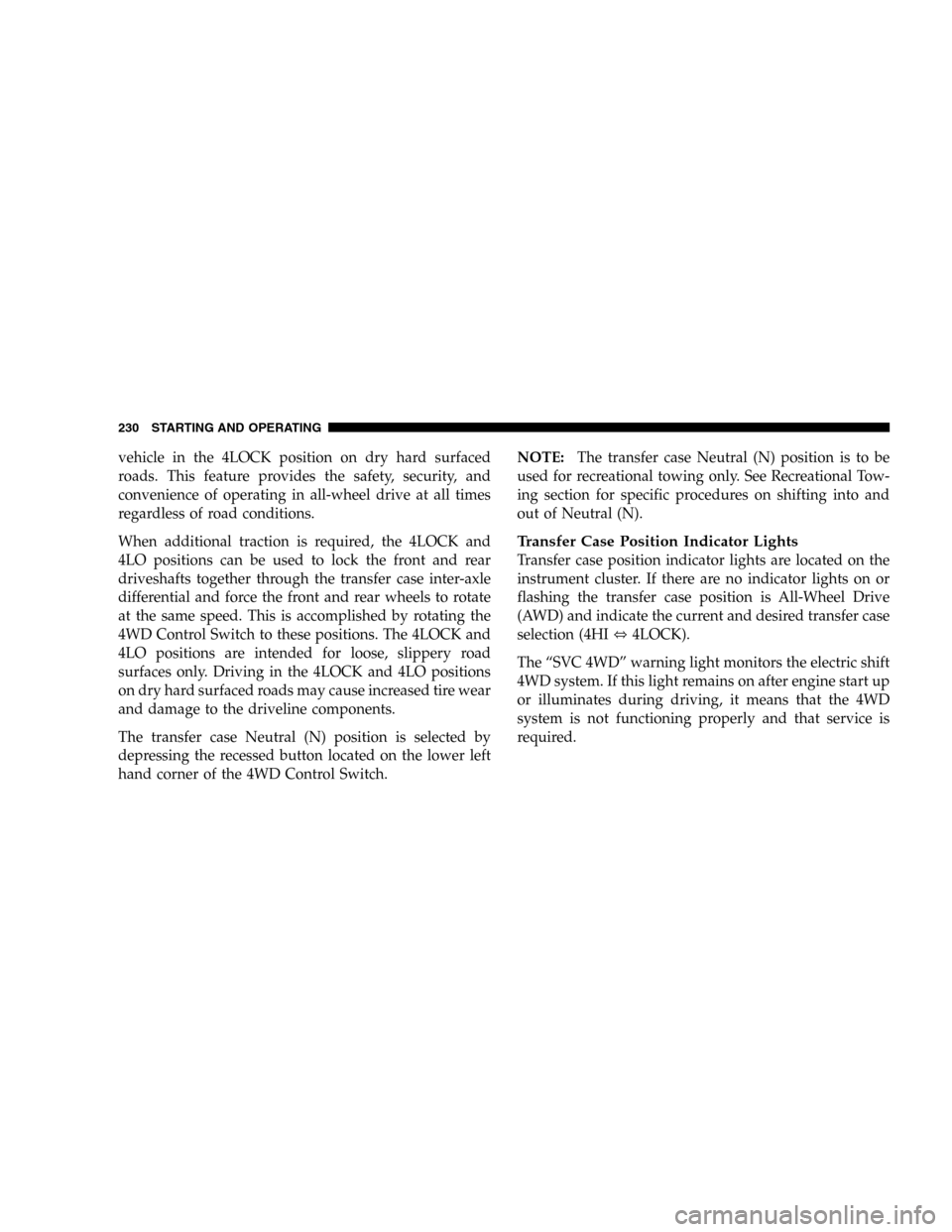
vehicle in the 4LOCK position on dry hard surfaced
roads. This feature provides the safety, security, and
convenience of operating in all-wheel drive at all times
regardless of road conditions.
When additional traction is required, the 4LOCK and
4LO positions can be used to lock the front and rear
driveshafts together through the transfer case inter-axle
differential and force the front and rear wheels to rotate
at the same speed. This is accomplished by rotating the
4WD Control Switch to these positions. The 4LOCK and
4LO positions are intended for loose, slippery road
surfaces only. Driving in the 4LOCK and 4LO positions
on dry hard surfaced roads may cause increased tire wear
and damage to the driveline components.
The transfer case Neutral (N) position is selected by
depressing the recessed button located on the lower left
hand corner of the 4WD Control Switch.NOTE:The transfer case Neutral (N) position is to be
used for recreational towing only. See Recreational Tow-
ing section for specific procedures on shifting into and
out of Neutral (N).
Transfer Case Position Indicator Lights
Transfer case position indicator lights are located on the
instrument cluster. If there are no indicator lights on or
flashing the transfer case position is All-Wheel Drive
(AWD) and indicate the current and desired transfer case
selection (4HI⇔4LOCK).
The “SVC 4WD” warning light monitors the electric shift
4WD system. If this light remains on after engine start up
or illuminates during driving, it means that the 4WD
system is not functioning properly and that service is
required.
230 STARTING AND OPERATING